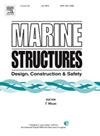Dynamic response modeling of sea-crossing bridge pier under the combined action of earthquakes and ocean waves using high-order time-domain boundary element method
IF 5.1
2区 工程技术
Q1 ENGINEERING, CIVIL
引用次数: 0
Abstract
A high-order time-domain boundary element method (TDBEM) for evaluating the combined impact of earthquakes and waves on sea-crossing bridge piers is presented, facilitating a comprehensive simulation of the interactions among seismic activity, wave forces, and structural responses. The proposed method is validated through numerical simulations from existing studies and benchmark model tests. An elliptical pier is used as a case study to analyze these combined effects. Results indicate that water depth significantly influences structural seismic responses due to changes in fundamental frequencies caused by added water mass. The influence of waves in the combined action is contingent upon the dominant seismic frequencies and the structural fundamental frequencies. When the structural fundamental frequency is far from typical ocean wave frequencies, fluid-structure interaction (FSI) effects amplify the peak response by 8 % to 25 %, depending on the ground motion's dominant frequency. When the structural fundamental frequency coincides with typical ocean wave frequency ranges, FSI effects exhibit an uneven influence on the structural response due to the inhomogeneity of wave-induced FSI effects. In such conditions, as the dominant frequency of ground motions increases, the suppression effect induced by wave FSI on the peak response may counterbalance or exceed the influence of earthquake-induced FSI effects.
地震与海浪共同作用下跨海大桥桥墩动力响应的高阶时域边界元模拟
提出了一种用于评估地震和波浪对跨海大桥桥墩综合影响的高阶时域边界元方法(TDBEM),有助于全面模拟地震活动、波浪力和结构反应之间的相互作用。通过已有研究和基准模型试验的数值模拟验证了该方法的有效性。以椭圆墩为例,分析了这些综合效应。结果表明,水深对结构的地震反应有显著影响,因为增加的水引起了基频的变化。在联合作用中,波的影响取决于主要地震频率和结构基频。当结构基频远离典型的海浪频率时,流体-结构相互作用(FSI)效应将峰值响应放大8%至25%,这取决于地面运动的主导频率。当结构基频与典型海浪频率范围重合时,由于波致FSI效应的非均匀性,FSI效应对结构响应的影响不均匀。在这种情况下,随着地震动主导频率的增加,波的FSI对峰值响应的抑制作用可能抵消或超过地震诱发的FSI效应的影响。
本文章由计算机程序翻译,如有差异,请以英文原文为准。
求助全文
约1分钟内获得全文
求助全文
来源期刊

Marine Structures
工程技术-工程:海洋
CiteScore
8.70
自引率
7.70%
发文量
157
审稿时长
6.4 months
期刊介绍:
This journal aims to provide a medium for presentation and discussion of the latest developments in research, design, fabrication and in-service experience relating to marine structures, i.e., all structures of steel, concrete, light alloy or composite construction having an interface with the sea, including ships, fixed and mobile offshore platforms, submarine and submersibles, pipelines, subsea systems for shallow and deep ocean operations and coastal structures such as piers.
 求助内容:
求助内容: 应助结果提醒方式:
应助结果提醒方式:


